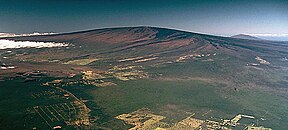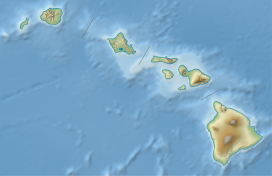
Back Mauna Loa Afrikaans مونا لوا Arabic Mauna Loa AST Mauna Loa BCL Мауна-Лоа Byelorussian Мауна Лоа Bulgarian মাউনা লোয়া Bengali/Bangla Mauna Loa Catalan Mauna Loa CEB ماونا لوا CKB
| Mauna Loa | |
|---|---|
 Mauna Loa as seen from the air. Hualālai is visible in the background. | |
| Highest point | |
| Elevation | 13,679 ft (4,169 m)[1] |
| Prominence | 7,079 ft (2,158 m)[2] |
| Listing | |
| Coordinates | 19°28′46″N 155°36′10″W / 19.47944°N 155.60278°W |
| Geography | |
| Parent range | Hawaiian Islands |
| Topo map | USGS Mauna Loa |
| Geology | |
| Rock age | 700,000–1 million[3] |
| Mountain type | Shield volcano |
| Volcanic arc/belt | Hawaiian-Emperor seamount chain |
| Last eruption | November 27, 2022 - December 13, 2022 |
| Climbing | |
| First ascent | Ancient times |
| Easiest route | Ainapo Trail |
Mauna Loa (/ˌmɔːnə ˈloʊ.ə, ˌmaʊnə -/, Hawaiian: [ˈmɐwnə ˈlowə]; lit. 'Long Mountain'[1]) is one of five volcanoes that form the Island of Hawaii in the U.S. state of Hawaii in the Pacific Ocean. Mauna Loa is Earth's largest active volcano[1] by both mass and volume. It was historically considered to be the largest volcano on Earth until Tamu Massif was discovered to be larger.[4] Mauna Loa is a shield volcano with relatively gentle slopes, and a volume estimated at 18,000 cubic miles (75,000 km3),[5] although its peak is about 125 feet (38 m) lower than that of its neighbor, Mauna Kea.[6] Lava eruptions from Mauna Loa are silica-poor and very fluid, and tend to be non-explosive.
Mauna Loa has likely been erupting for at least 700,000 years, and may have emerged above sea level about 400,000 years ago. Some dated rocks are 470,000 years old.[7] The volcano's magma comes from the Hawaii hotspot, which has been responsible for the creation of the Hawaiian Island chain over tens of millions of years. The slow drift of the Pacific Plate will eventually carry Mauna Loa away from the hotspot within 500,000 to one million years from now, at which point it will become extinct.
Mauna Loa's most recent eruption began on November 27, 2022, and ended on December 13, 2022. It was the first eruption since 1984.[8][9] No recent eruptions of the volcano have caused fatalities, but eruptions in 1926 and 1950 destroyed villages, and the city of Hilo is partly built on lava flows from the late 19th century.
Because of the potential hazards it poses to population centers, Mauna Loa is part of the Decade Volcanoes program, which encourages studies of the world's most dangerous volcanoes. Mauna Loa has been monitored intensively by the Hawaiian Volcano Observatory since 1912. Observations of the atmosphere are undertaken at the Mauna Loa Observatory, and of the Sun at the Mauna Loa Solar Observatory, both located near the mountain's summit. Hawaii Volcanoes National Park covers the summit and portions of the southeastern and southwestern flanks of the volcano, and also incorporates Kīlauea, a separate volcano.
- ^ a b c "Mauna Loa". USGS. Retrieved December 19, 2023.
- ^ "Mauna Loa, Hawaii". Peakbagger.com. Retrieved December 12, 2012.
- ^ Cite error: The named reference
hvo-loawas invoked but never defined (see the help page). - ^ Cite error: The named reference
tamuwas invoked but never defined (see the help page). - ^ Kaye, G.D. (May 14, 2002). Using GIS to estimate the total volume of Mauna Loa Volcano, Hawaii. Geological Society of America. 98th Annual Meeting. Archived from the original on January 25, 2009. Retrieved August 5, 2007.
- ^ "Mauna Kea". NGS Station Datasheet. United States National Geodetic Survey. November 28, 2022.
- ^ Jicha, B.R.; Rhodes, J.M.; Singer, B.S.; Garcia, M.O. (2012). "40Ar/39Ar geochronology of submarine Mauna Loa volcano, Hawaii". Journal of Geophysical Research: Solid Earth. 117 (B9). doi:10.1029/2012JB009373.
- ^ "HAWAIIAN VOLCANO OBSERVATORY VOLCANO OBSERVATORY NOTICE FOR AVIATION Monday, November 28, 2022, 09:45 UTC | USGS Hazard Notification System (HANS) for Volcanoes". volcanoes.usgs.gov. November 27, 2022. Retrieved November 28, 2022.
- ^ "Hawaii's Mauna Loa volcano erupts for first time in 38 years". The Washington Post. ISSN 0190-8286. Retrieved November 29, 2022.

